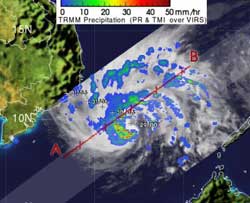NASA's TRMM satellite sees newborn Tropical Storm Pakhar's heavy rain

NASA's TRMM satellite measured rainfall rates in Tropical Storm Pakhar on March 29 at 1123 UTC (7:23 a.m. EDT).Light to moderate rainfall is depicted in blue and green, falling at a rate between .78 to 1.57 inches (20 to 40 mm) per hour. Heavy rainfall is seen in red, and is falling at 2 inches/50 mm per hour. Credit: SSAI/NASA, Hal Pierce<br>
NASA's Tropical Rainfall Measuring Mission (TRMM) satellite passed over Pakhar on March 29, and saw that it was generating mostly light to moderate rainfall around the entire system, with areas of heavy rain in the southwestern and northeastern quadrants.
Light to moderate rainfall rates were between .78 to 1.57 inches (20 to 40 mm) per hour and heavy rain was falling at a rate of 2 inches/50 mm per hour. The banding of thunderstorms has continued to consolidate and strengthen since March 28, which accounts for the cyclone's increase in strength.
On March 29 at 1500 UTC (11 a.m. EDT) Pakhar's maximum sustained winds virtually exploded from 35 knots (40.2 mph/64.8 kph) to 60 knots (69 mph/111 kph) within 12 hours because it is in an environment with lower wind shear and warm sea surface temperatures.
Pakhar is centered near 10.0 North and 111.6 East, about 300 nautical miles east of Ho Chi Minh City, Vietnam. It is moving to the west-northwest near 3 knots (3.4 mph/5.5 kph).
Forecasters at the Joint Typhoon Warning Center expect Pakhar to make landfall in central Vietnam, north of Ho Chi Minh City on March 31. Residents should prepare for rough surf along beaches, gusty winds and heavy rainfall.
Media Contact
More Information:
http://www.nasa.govAll latest news from the category: Earth Sciences
Earth Sciences (also referred to as Geosciences), which deals with basic issues surrounding our planet, plays a vital role in the area of energy and raw materials supply.
Earth Sciences comprises subjects such as geology, geography, geological informatics, paleontology, mineralogy, petrography, crystallography, geophysics, geodesy, glaciology, cartography, photogrammetry, meteorology and seismology, early-warning systems, earthquake research and polar research.
Newest articles

Trotting robots reveal emergence of animal gait transitions
A four-legged robot trained with machine learning by EPFL researchers has learned to avoid falls by spontaneously switching between walking, trotting, and pronking – a milestone for roboticists as well…

Innovation promises to prevent power pole-top fires
Engineers in Australia have found a new way to make power-pole insulators resistant to fire and electrical sparking, promising to prevent dangerous pole-top fires and reduce blackouts. Pole-top fires pose…

Possible alternative to antibiotics produced by bacteria
Antibacterial substance from staphylococci discovered with new mechanism of action against natural competitors. Many bacteria produce substances to gain an advantage over competitors in their highly competitive natural environment. Researchers…





















